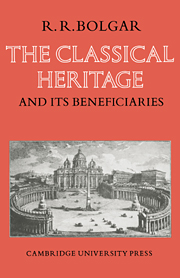Book contents
- Frontmatter
- Contents
- Preface to 1973 impression
- Introduction
- Chapter I The Background
- Chapter II The Greek East
- Chapter III The Carolingian Age
- Chapter IV The Pre-scholastic Age
- Chapter V The Scholastic Age
- Chapter VI Collapse and New Beginnings
- Chapter VII The High Renaissance
- Chapter VIII The End of the Renaissance and the Appearance of New Patterns in Classical Education and Scholarship
- Chapter IX Education and the Classical Heritage
- Notes
- Appendix I Greek MSS. in Italy during the Fifteenth Century
- Appendix II The Translations of Greek and Roman Classics before 1600
- Index
Chapter VII - The High Renaissance
Published online by Cambridge University Press: 29 January 2010
- Frontmatter
- Contents
- Preface to 1973 impression
- Introduction
- Chapter I The Background
- Chapter II The Greek East
- Chapter III The Carolingian Age
- Chapter IV The Pre-scholastic Age
- Chapter V The Scholastic Age
- Chapter VI Collapse and New Beginnings
- Chapter VII The High Renaissance
- Chapter VIII The End of the Renaissance and the Appearance of New Patterns in Classical Education and Scholarship
- Chapter IX Education and the Classical Heritage
- Notes
- Appendix I Greek MSS. in Italy during the Fifteenth Century
- Appendix II The Translations of Greek and Roman Classics before 1600
- Index
Summary
THE POPULARISATION OF A NEW METHOD OF STUDY
When the fourteenth century gives way to the fifteenth, we seem to pass from the gloom of a passage into the brilliant light of a sunlit room. The long process whose stages we have been tracing now reaches its climax. The widened interests of scholarship embrace for the first time the whole of the classical heritage. Not only is the movement started by Petrarch for the recovery of Roman eloquence and the Roman way of life brought to a triumphant conclusion, but the work of earlier ages in law, medicine and philosophy is once again examined, criticised and completed. Moreover, the cultural scene is enriched and complicated at this juncture by the almost simultaneous appearance of two new elements. Greek studies which had so long wilted in obscurity take their place alongside Latin, their long-hidden treasures accessible at last to a multitude of scholars; and the invention of printing radically changes the basic conditions of education and research. The world suddenly wears a different face.
The impressive growth of trade, the collapse of feudal independence, better government and a greater mastery of material resources, new discoveries and new ideals, all played their part in effecting this transformation, which involved the educational field along with the rest. But if our interest goes beyond the mere fact of progress, and we want to understand why the new education took the form it did, we must look beyond the broad social and political factors to a more specific cause. We must look to the work of the teachers.
- Type
- Chapter
- Information
- The Classical Heritage and its Beneficiaries , pp. 265 - 301Publisher: Cambridge University PressPrint publication year: 1973
- 2
- Cited by

